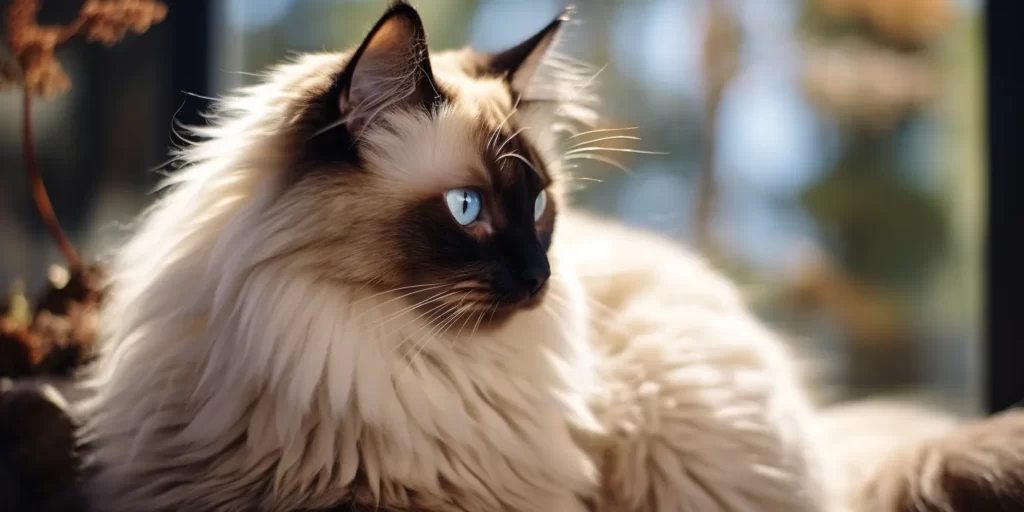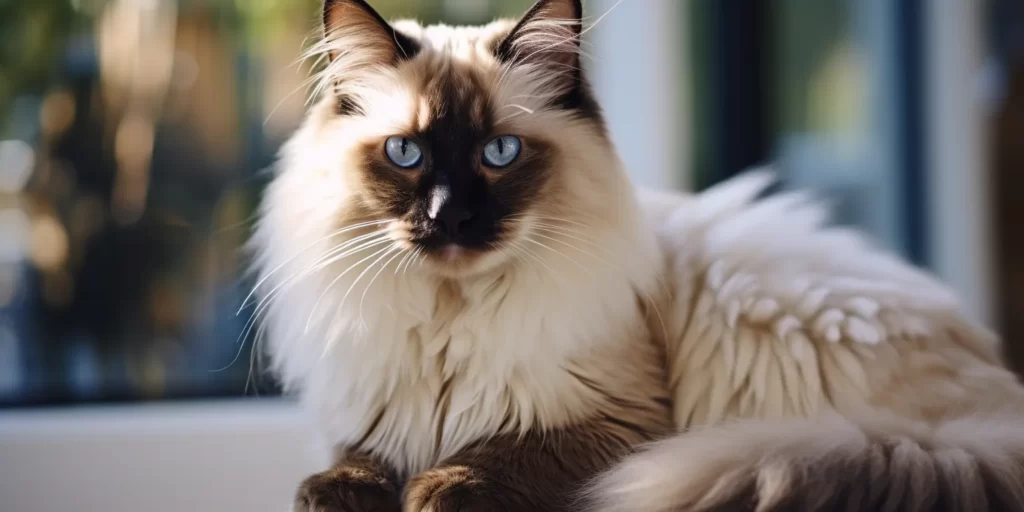Deciding to bring a Balinese cat into your home can be a rewarding experience. These elegant and affectionate creatures are known for their striking appearance and friendly disposition. However, potential owners often ponder the differences between male vs female Balinese cats.
Both sexes can provide immense companionship, yet they might present subtle differences that can influence your decision. In this comprehensive blog, we will delve into the nuances that distinguish between male and female Balinese cats to help you make an informed decision.
When discussing the male vs female Balinese cat, it’s essential to look beyond their luxurious coats and mesmerizing eyes. Each gender carries distinctive traits that could sway your preference depending on what you are looking for in a feline friend.
As we explore these differences, keep in mind that individual personalities can vary widely, and upbringing and environment also play crucial roles in shaping a cat’s character.

Visual Differences
| Male | Female | |
|---|---|---|
| Average height (adult): | 8 – 11 inches | 8 – 11 inches |
| Average weight (adult): | 12 – 15 pounds | 8 – 12 pounds |
| Lifespan: | 18 – 22 years | 18 – 22 years |
| Energy Level: | High | High |
| Grooming needs: | Moderate | Moderate |
| Family-friendly: | High | High |
| Other pet-friendly: | High | High |
| Trainability: | Moderate to High | Moderate to High |
Male Breed Overview
Male Balinese cats are often lauded for their regal demeanor and loving nature. These long-haired beauties, thought to be the long-coated variety of the Siamese, carry themselves with an air of confidence that can captivate anyone’s heart.
Physically larger than their female counterparts, male Balinese have a robust build that reflects their playful and sometimes boisterous spirit. They tend to have a strong presence in the home, weaving their way into the daily lives and routines of their human companions with great enthusiasm.
Interestingly, their social behavior often leads to male Balinese forming strong bonds with their human families. They are known for being vocal, sharing their opinions with a series of chirps and meows that can entertain or, at times, demand attention.
Their intelligence is another key aspect that shines through – male Balinese cats are quick learners and can often be taught tricks or habits with relative ease. This makes them fascinating pets for those who enjoy interactive play and teaching their feline friends new skills.
Male Balinese cats are also known for their territorial instincts. While they may be sociable and friendly creatures, they need space to call their own. This can sometimes lead to disputes if other male cats are present within the same household, making it crucial to introduce new pets carefully or consider neutering to curb such behaviors. When cared for in an appropriate environment with adequate stimulation, male Balanese make superb, affectionate pets.

Training A Male
When it comes to training a male Balinese cat, patience and positive reinforcement are key. These cats are intelligent and receptive to learning; however, they also have a playful side that may distract them from training sessions. It’s best to keep training exercises short and engaging, using treats or toys as motivation.
Socialization is another critical component for male Balinese kittens – early exposure to various people, tranquil pets, and different environments can help in their development into well-adjusted adults.
It’s also worth noting that male Balinese cats can be quite territorial, which is important to consider during training and socialization. Introducing them slowly to new pets and giving them consistent attention can alleviate any potential stress or behavioral issues. Scratching posts, high perches, and cat trees can satisfy their need for territory within your home and provide them with their space.
Additionally, males may display more marking behaviors, especially before being neutered. Training them on appropriate litter box usage early on will mitigate unwanted habits, and ensuring they have easy access to clean litter boxes will keep these behaviors at bay.
Health & Care
While both male and female Balinese have similar health concerns, males may have the propensity for certain issues simply due to their size and nature. Larger body size might lead to joint concerns as they age; hence maintaining a healthy weight through diet and regular exercise is crucial.
Neutering not only helps prevent unwanted litters but also reduces the risk of testicular cancer and prostate problems which could be of concern in unaltered males.
One common health issue seen in many cat breeds, including the Balinese, is dental disease. Due to the male’s robust appetite, they can be more susceptible if not monitored properly. Regular dental check-ups, brushing their teeth, or providing dental hygiene treats will help maintain their overall health.
In terms of grooming, while both sexes require regular brushings due to their longer hair, males might need extra grooming sessions as they are bigger and might shed more. Keeping up with these grooming needs will make sure they don’t develop mats or tangles in their luxuriant coats.

Suitable for:
Male Balinese cats are especially suitable for families looking for an interactive and social feline companion. Their playful nature makes them excellent pets for households with children who understand how to handle animals gently. They also thrive in environments where there’s plenty of space for them to explore and where they can receive ample attention from their human companions.
Furthermore, males might be more fitting for those who have a more active lifestyle and enjoy engaging with their pets regularly. With the right socialization, males tend to do well in homes with other pets too, though careful introductions are necessary as mentioned before. A potential owner willing to invest time in training, social interactions, and regular grooming will find a perfect companion in a male Balinese cat.
Female Breed Overview
Female Balinese cats exhibit an elegance that’s hard not to admire. They tend to be slightly smaller in stature than male Balinese but do not fall short when displaying their captivating personalities. Female cats of this breed are generally graceful movers and have a delicate poise that makes them seem quite ladylike. Despite appearing somewhat more reserved than males, females create intense bonds with their families and show similar levels of affection once they feel secure and loved.
The dynamic nature of female Balinese cats contrasts with the males’ playfulness; females might prefer quieter interactions but remain just as engaged with their human companions. They limberly navigate their territories within the home with caution and attentiveness. A female Balinese typically shows less desire for dominance than a male but still asserts herself gracefully within a household dynamic.
Moreover, when considering the female Balinese temperament, it is notable that these cats often carry maternal instincts regardless of whether they are spayed or have had kittens themselves. These instincts translate into nurturing behaviors not just toward human family members but also other pets in the home.

Training A Female
Female Balinese cats are usually receptive to training if approached with a gentle demeanor. They can exhibit great concentration when intrigued by a task or game, making them apt pupils for various commands or tricks. Just like males, they benefit from consistency in training routines garnished with affectionate praise or tantalizing treats as rewards.
While they also appreciate socialization early on in life, female Balanese might require less intense social encounters compared to males; smaller friend groups or quieter settings may yield better results during these exercises. However, neglecting proper socialization could lead them towards skittish behavior or unease around strangers or new pets.
Toilet training usually goes smoothly with female Balinese cats as they tend to keep clean habits naturally. Still, maintaining pristine litter box conditions will encourage continued proper use through adulthood. Because females may be more methodical, creating structured schedules for playtime, feedings, and training helps them understand what is expected of them within their home environment.
Health & Care
The health considerations for female Balinese don’t drastically deviate from those of males. They possess similar risks concerning genetic conditions endemic to the breed such as respiratory problems or issues stemming from their dental hygiene which must not be ignored regardless of gender.
For females specifically, spaying is highly recommended – not only does it prevent unwanted litters but it significantly decreases risks associated with ovarian or uterine cancers which could otherwise become prevailing concerns as they age.
Grooming routines are similar between sexes; females still require regular brushings but might do so less frequently than males due to being slightly smaller in size and potentially shedding less. It’s crucial nonetheless to maintain a grooming routine that includes periodic baths as needed especially since the female’s finer coat may become oily quicker than that of a male.

Suitable for:
For those looking for a more gentle presence or perhaps living in smaller spaces like an apartment, female Balinese cats might be a suitable choice due to their slightly smaller size and typically more subdued demeanor compared to males. They are well-suited companions for individuals or families seeking a loving pet who prefers a calmer environment yet still displays curiosity and engagement with her human counterparts.
Females may also be preferable if there is already another cat in the home – they can adjust well within multi-cat households given time and proper introductions particularly if other pets are not overly assertive. Family dynamics including older children or elderly members who might appreciate a less boisterous companion would benefit from her gentle mannerisms.
A prospective owner who can provide routine care while offering consistent affection will find in a female Balanese an endearing and loyal companion.
Which One Is Right for You?
Deciding between a male vs female Balanese ultimately depends on what you’re seeking within your family dynamic. While both genders share many traits inherent to the breed such as sociability intelligence and affection each offers unique characteristics that may align better with different homes lifestyles or personal preferences.
Thinking about your daily routine expected levels of interaction desired playfulness territory management or specific social scenarios could guide you toward which gender would integrate best within your life.
For some future owners size matters; thus knowing that males tend to be somewhat larger could impact your choice especially if you live in confined spaces. Additionally considering existing pets co-habitability becomes crucial as males might display more territorial behaviors compared to females who generally adjust better in multi-pet environments.
Nevertheless, proactive training right from early kittenhood along with harmonious socialization efforts will ensure whichever gender you choose becomes an irreplaceable member of your family. Remember each cat is an individual regardless of sex allowing its unique personality to shine through when placed in nurturing respectful environments.

Conclusion
Pondering between acquiring a male vs female Balinese cat brings many considerations into focus – every cat owner’s situation is distinct just like every cat’s personality. When choosing any pet particularly one from such a charismatic captivating breed like the Balanese it boils down to recognizing which traits behaviors or needs align well with what you want to bring into your life.
Remember always consider adopting from shelters where you might find either gender waiting for someone just like you. The nuances between genders could tilt favour one over the other both can provide immeasurable joy and companionship when cared for loved revered.
Celebrate your decision to embark on an enriching journey whether it leads you to be owned by a male-female majestic intelligent loving Balinese cat.